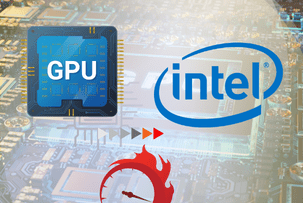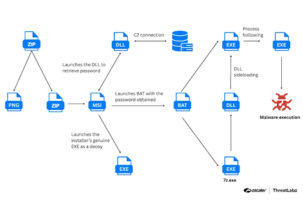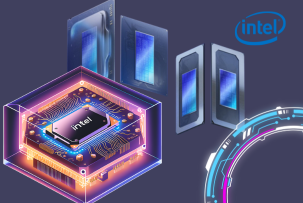Top 6 Cybersecurity Trends in 2024
16:26, 29.03.2024
The year 2023 has brought about many innovations in the world of technology. The cybersecurity sector wasn’t an exception. The integration of AI into the many products and solutions on the market changed the approach to cybersecurity as well.
Now, organizations and businesses utilize AI to enhance their malware detection systems and cybersecurity protocols.. However, hackers and bad actors also keep up with the latest updates in the industry, and thus the vulnerability recognition, its exploitation, and cybersecurity threats associated with them have evolved.
With that said, let’s explore the top 6 cybersecurity trends for 2024.
1. Advancements in Attack Vectors Sophistication
Based on our experience, new types and vectors of cyber attacks emerged. Knowing the kinds of threats that are possible can prevent the exploitation of system vulnerabilities. New cyber attacks follow the protocols of technical exploits and centralized social planning.
The types of attacks and potential vectors for them go as follows.
Ransomware attacks
Ransomware is a type of malicious software that’s designed to prevent authentication and restrict user access to certain files. The restriction is posed through encryption protocols.
Ransomware attacks often involve demanding payment for allowing access to the files, often with the purpose of financial gain in mind.
The “trend” for ransomware attacks began in 2017 with the WannaCry worldwide ransomware attack. Now, this type of attack continues to resurface and threaten critical infrastructure and well-known companies through the combination of technical exploits and social engineering.
Several types of ransomware can be used to conduct the attacks including:
- • Screen lockers, which are programs that don’t allow the user to access data, and demand payments to proceed.
- • Scareware, that shows a false warning message notifying that some kind of virus has been detected.
- • DDoS extortion, which creates a threat of launching a DDoS attack.
Those are just a few, common ways how ransomware attacks can be carried out. This type of attack remains one of the most widespread threats to cybersecurity.
Endpoint-delivered threats
Endpoint-delivered threats include actions aimed at people who work in targeted companies and possible unintentional “malware infection” of the corporate systems carried out by their hands. It can look like leaving a USB drive with malicious software on it, hoping that someone will find it and get curious enough to explore its contents through the corporate network; this way attackers get the sensitive data of the organization.
Endpoint-delivered attacks sometimes involve a portable device delivered and left in proximity to the physical infrastructure of the organization. This type of cybersecurity threat is difficult to execute because it can be costly, risky for attackers themselves, and resource-consuming if carried out remotely.
This type of attack can also be carried out in another way. Attackers that attempt to pose targeted threats also use social engineering to compromise user endpoints: it can look like sending emails to corporate addresses to compromise user endpoints. This type of attack is much easier to execute (even remotely); plus it is more affordable since you can target threats at multiple users at a time over different periods.
While the actual execution of the attacks may vary in form, it is always targeted at privileged devices, like computers, phones, or IoT devices.
Identity-based attacks
Identity-based attacks exploit vulnerabilities related to one’s identity, authentication, and other sensitive data or personalized processes.
This type of attack is targeted toward getting access to personal data and then threatening to reveal it. Identity-based attacks can be carried out through identity theft, phishing, and attacks on SSO systems and MFA protocols.
Cloud attacks
Cloud attacks target weak or flawed authentication algorithms for accessing cloud repositories to intervene with cloud functioning.
Attacks on cloud storage, rooted in the exploitation of storage services, also deserve attention. Their concept involves shifting focus from endpoints and targeting the services of the cloud network.
Recent cloud attacks involved spreading tools through Telegram channels, which exposed cloud authorization data.
Cloud attacks have been on the rise lately, with the most common reason for issuing being the potential for financial gain. And the way they are being issued proves that the whole landscape of cybersecurity threats is evolving along with innovations on the technological front.
2. Integration of Machine Learning and AI in Cyber Attacks
Artificial intelligence streamlined transformations in how technology is integrated into different areas, some of which are crucial to our day-to-day lives, like, for example, healthcare. But as much as it affects everything else, AI, perhaps, powered cybersecurity the most.
AI continues to evolve, and so do the cyber threats, with bad actors now exploiting AI’s capabilities. Machine learning can help detect and take advantage of system vulnerabilities, and identify software patterns. For example, phishing attacks conducted using AI can include incredibly convincing messages by analyzing communication patterns.
As unsettling as it may seem, AI also helps integrate advanced security mechanisms to strengthen its defense. Machine learning can help analyze potential threats and attack patterns, predict attack vectors, and enable alerts for quicker reactions and implementation of defense strategies.
3. Embracing Consolidated Security Vendor Strategies
Since the potential range of cyber attacks is continuously growing, businesses using many (or too many applications) put themselves at higher risk of cyber intrusion due to the complexity of application management, and insufficient security coverage.
As an optimal security strategy, businesses and enterprises are strongly advised to implement continuous threat management, which implies an extended assessment of potential threats. Based on our experience, it, in turn, can lead to easier cross-platform management, wide coverage and consistent security strategy, and effective security threat response.
4. The Emergence of Ransomware 2.0
Ransomware 2.0 is the next level of ransomware evolution that includes enhancements utilizing the latest innovations, in the technique of attacks, and their increased personalization.
Ransomware 2.0 not only encrypts data for further exploitation, but also adapts to behavioral patterns, filtrates sensitive data before encryption, and overall creates more thought-through attack tactics.
Here’s how Ransomware 2.0 attacks are carried out:
- Accessing and stealing the data
The attacks begin with using various methods like phishing, malware, and compromised software to access the system. Then critical data is stolen, and might even be filtered beforehand.
- Encrypting and restricting data access
Once the attackers get a hold of the sensitive data, they encrypt it in a way that makes them impossible to use or access. In this scenario, encryption is performed in a way, where only the attackers themselves can recover the access to the data.
Users often receive notifications about blocked access along with demanding payment (often in cryptocurrency) for the decryption key or not leaking the data.
- Extorting the pressure
This aspect is what “2.0” means in “Ransomware 2.0”, and it is the double extortion and double pressure. Not only an individual user undergoes stress from their confidential data being compromised, but also risks, as the attackers claim, it being released to the public. Along with it, ransomware 2.0 attacks often involve copying the data to another location before it is encrypted.
When it comes to businesses, the release of corporate data can harm the reputation of the business, and lead to financial losses and legal consequences.
- Paying and potentially recovering data
We want to emphasize that there’s no guarantee that your data will be recovered after you complete the demanded payment.
Based on what we have observed, most scammers demand payment to be issued to the crypto wallet. After the payment is successful, bad actors claim to give you the decryption key that could potentially recover your access to the data.
However, there’s no guarantee that your data hasn’t been transferred to another device or storage space, or hasn’t already been leaked.
This all goes to show that Ransomware 2.0 is a serious threat, and the best practices of cybersecurity should be implemented to prevent the attack or be able to defend your data after the incident.
Statistics on ransomware 2.0 attacks
Panda Security reported a recent rise in ransomware attacks with double extortion. Specifically, the incidence of moving data to other devices, or digital spaces has increased as a manifestation of the evolution of ransomware attacks. Not only do bad actors demand ransom for a data decryption key, but they also demand payment as a preventative measure for not leaking copied data from users of organizations. And this is how the double extortion context is created.
Among the highlights of ransomware attacks in 2023 is the activity of the LAPSU$ group that targeted Microsoft, Uber, and Nvidia and then released stolen data once the ransom demand was not met.
When it comes to protection against ransomware attacks, methods like backup and recovery protocols are no longer enough to prevent the threat. The primary concern here is that ransomware groups are building a business on attacks on the dark web, where cybercriminals can purchase the whole ransomware infrastructure and then use it to target cyber attacks. it shows that the ransomware landscape has broadened with many malicious intricacies possibly being planted across reputable platforms. Thus, the way businesses and organizations approach ransomware 2.0 attacks should be characterized as serious and of wide coverage.
5. Navigating the Challenges of Exploiting Remote Work Infrastructure
Remote work has long become a regular aspect of everyday life. Many companies use platforms and tools to provide remote access to their employees, and often the remote access algorithms become a target of cyber attacks. An example of a vulnerability associated with remote access can be Citrix vulnerability.
Recently, there was a release of recommendations regarding preventing the exploitation of a specific vulnerability - CVE-2023-3519, that originated in Citrix’s NetScaler Application Delivery Controller and NetScaler Gateway. Due to this vulnerability, the Citrix NetScaler was under attack for almost three months, and the bug could not be fully fixed with regular security practices.
The ransomware group LockBit 3.0, allegedly based in Russia, launched an attack on international Boeing corporation, and other companies exploiting the vulgarity in Citrix’s software. The group was able to bypass the authentication mechanisms and infiltrate user sessions.
Familiarity with cases like this one can help your organization navigate and spot the vulnerabilities in your remote work environments.
6. Escalating Threats in the Realm of IoT Attacks
In 2023, according to the SonicWall reports, more than 77 million attacks were conducted, which is 20 million more than in 2022, some of them were targeted towards IoT devices. Thus, IoT security is a separate topic that deserves attention.
Cybersecurity trends that are expected to emerge in the context of IoT devices include better authentication and encryption protocols and access policies. With that, strengthening of security across the IoT sector can make a huge difference, since the data exchanges between IoT devices will be more secure, and protected from the chance of any attacks.
What can be done additionally to enhance security is integrating edge computing within the IoT structures. Edge devices can process data locally without the need for regular or frequent data network transferring.
It is also anticipated that the aspect of cybersecurity will be seen in the approach to the design and development of IoT devices. Implementing security-by-design principles into the device’s design reduces the amount of vulnerabilities to their minimum.
To Sum Up
Adapting to the new fundamentals of cybersecurity is not easy, especially with technological advances being presented so frequently nowadays. However, we have to remember that as technology becomes more sophisticated, the bad actors become smarter when it comes to exploiting it.
Thus, to be ahead of them you shouldn’t neglect following the cybersecurity trends and be hesitant to implement them. You never know where the next attack will be targeted at, but it can be somewhat predicted. The point is to sufficiently protect your organization, and make sure you follow the latest cybersecurity trends.


